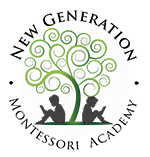Montessori History
The Name Carried by Millions
Jean Piaget, Erik. H Erikson, Lev Vygotsky,
Maria Montessori: The name carried by millions of schools across the world did not come without hard work and dedication..
Born on the 31st of August 1870 in the town of Chiaravalle, Italy, Maria Montessori is admired as the first female in Italy to become a physician, educator, and innovator.

From the beginning
Always one of the top students from her class, Montessori broke any barriers between her and a life-long dream of success and equal rights. At age 13 she entered an all-boys technical institute to graduate in engineering.
Fortunately for us, she decided to study medicine instead. After being rejected to the University of Rome’s medical program, she kept working for her goal with determination. Once accepted into the medical program, she became the first female physician in Italy in 1896.
As a female, Dr. Montessori was not permitted to practice medicine in Italy’s hospitals. For that reason, she continued her studies in research programs; a very important one being the psychiatric clinic of the University of Rome, as a volunteer. Here is where she found her inner calling, which held a deep interest for children with special needs. After working for years with children who were born with learning disabilities, she began to advocate her experience. She held firm to the fact that there was not enough support nor assistance for children who simply learned in different ways.
Her Legacy: The Montessori Method
1907, Maria was given the opportunity to open her own childcare in the slums of Rome. Now known as the first Casa dei Bambini, here is where Dr. Montessori perfected her method through observations of the children. Bringing over the material she created in the Orthophrenic school, she created a quality Montessori learning environment for young children, children with no past education, where they were introduced to hand-on lessons of mathematics, language, sensorial, cultural areas and practical life. She began to observe something miraculous: where her children with learning disabilities had to be pushed to advance through this material, the children under her care seemed to be naturally attracted to the work they were introduced.
She then noticed something even more amazing- the discipline problems once held by the poverty-stricken children- had now vanished. Montessori discovered an unlimited potential in children to learn. Montessori discovered that her children showed more interest in academic manipulative rather than toys. She watched the children teach themselves, absorb knowledge and thrive under this environment.

Montessori Education
It took no time for the news to get around Rome, and everyone began wondering how this could be possible. Children left in the streets to wander were now reading, writing and performing high-end mathematics problems such as addition, subtraction, skip counting and multiplication.
With the great success of Casa dei Bambini, Dr. Montessori began to open more schools, the method began to spread and many leaders and scientists began to praise her work.
She spread her research findings in speeches throughout Europe, also using her platform to advocate for women’s and children’s rights.
Although she was advocating through war and political upheaval- which inspired her to add peace education to the Montessori curriculum- she kept fighting for her work and became one of the most influential women to the education system we know today. Thanks to her effort, perseverance, dedication, and observations, Dr. Maria Montessori was able to create the method we live by today.
She spread her research findings in speeches throughout Europe, also using her platform to advocate for women’s and children’s rights.

